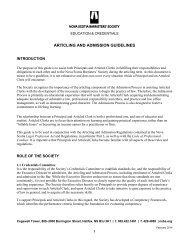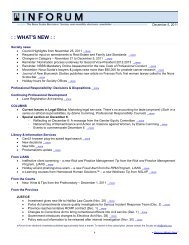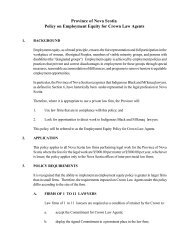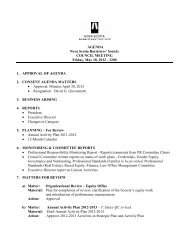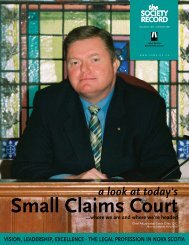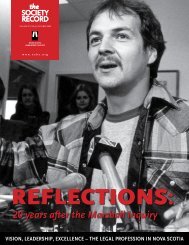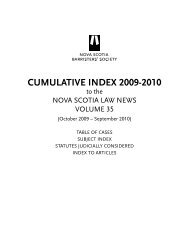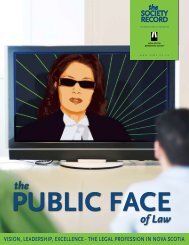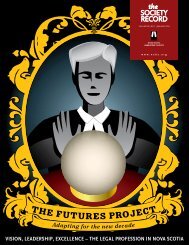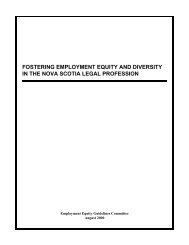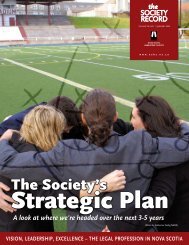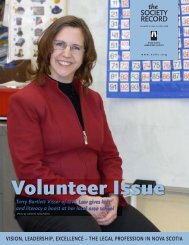SR Vol 24 No 5, October 2006 - Nova Scotia Barristers' Society
SR Vol 24 No 5, October 2006 - Nova Scotia Barristers' Society
SR Vol 24 No 5, October 2006 - Nova Scotia Barristers' Society
- No tags were found...
You also want an ePaper? Increase the reach of your titles
YUMPU automatically turns print PDFs into web optimized ePapers that Google loves.
Business As Usual? Three lawyers weigh in on life after the capJohn Rafferty, Q.C.Burchell MacDougall, Truro, NSsuspect that my experience withI personal injury claims since theamendments to the Insurance Actand regulations is no different thanthat of any other personal injurylawyer. The number of claimantscontacting me for advice has dramaticallydropped. I inform thosewho do contact me about the newreality since tort reform and the legal issues surrounding thecourt challenge to the validity of the amendments. I tell themthat if the challenge to the legislation is not successful, thereis unlikely to be enough money recovered to justify the substantiallegal fees which may result from the management of allaspects of their claim. These people are then confronted withthe uncertainties of whether their injuries, some very serious,will nonetheless be “minor injuries” as defined in the Act and,if so, whether the Act and Regulations will withstand the legalchallenge currently being mounted. Typically, the tort claim thengoes into a “holding pattern” pending resolution of their injuriesand of the challenge.While claimants wait for their injuries to heal or reach a plateauwith varying amounts of chronic difficulties, they often have anumber of other legal issues which require immediate attention.They may need help with their Section B auto insurance claims forboth medical benefits and loss of income. They may be entitled toprivate disability insurance benefits, employment insurance, CanadaPension, Workers Compensation, or disability insurance onloans or other benefits. They often need help coordinating thesebenefits where there is an overlap, especially with Section B benefits;the rules for and interrelationship between these programscan be a maze.When a person injured in a car accident seeks my help, they typicallydo not have the financial ability to pay my regular hourly rateto assist with these ancillary issues. Even if they do, the legal costsare often greater than the amounts in dispute. In the past, adviceand legal services on all of these matters was generally providedwithout charging a direct fee, recognizing that our time would berecouped in the contingency fees charged for the tort claim. <strong>No</strong>wI undertake to provide a base level of service, without a realisticexpectation of payment, because the individuals are in need. I seethis as an access to justice issue.I believe the legislation has delivered a double whammy to bothpersonal injury litigators and the injured. For the lawyer, fees generatedfrom personal injury files have largely dried up. In addition,much of the new work is done pro bono or at greatly reduced rates.For the injured party, not only are they denied a recovery appropriateto their pain and suffering, but, because they often do notbother to seek legal help, they deal with the indirect consequencesof their injuries alone and without adequate information.Anna Marie ButlerWagner & Associates, Halifax, NSSince the cap legislation andregulations were introduced,practising motor vehicle personalinjury cases has become full ofuncertainty, but also challenge andopportunity.The uncertainty relates to our clientsand the advice we give them.It’s difficult to explain that we have to “wait and see” for theresults of the ultra vires constitutional application and/or definitioncases to evolve. We would all prefer to give more specificguidance and counsel than we can right now.I believe the legislation and regulations discriminate againstwomen, children, the elderly, persons with psychological injury,and generally those less fortunate. People who may fall underthe cap for damages are left waiting. The people whom the legislationmost affects are people that in the past persevered in spiteof barriers, and they continue to do so. They are very acceptingof the “wait and see” advice I am so uncomfortable giving. However,the fact is that the cap of $2,500 is so low, there really is verylittle for them to lose by waiting.Persons with severe injuries clearly outside the cap are facedwith allegations that their injury may fall under the cap despiteoverwhelming evidence to the contrary. Applications for partpaymentsand negotiation to resolve a severe injury case are oftenan exercise in futility.Our clients are the victims of careless drivers. The cap legislationre-victimizes the client with all degrees of injury for the benefitof big business profits. Every person who has been or might beinjured in a motor vehicle accident is at risk, which leaves everymember of the public vulnerable to the legislation.As lawyers we have an obligation to challenge this victimizationand imposition on the public’s right to make a claim. This obligationgives us all the opportunity and challenge we are trainedto take. Whether it is the constitutional challenge or arguing thata case is not “minor”, we are going to have to work, think, andchallenge ourselves more than we have in the past. Every barrierbrings opportunity, with this being no exception, as it’s exciting tohave the opportunity to stand up for people’s rights.Members of the Bar have stepped forward to take the challengefor the purpose of public interest. Barry Mason will be arguingthe Application regarding the ultra vires constitutional challenge.He deserves much credit for taking on such an immense task.Before the cap, getting lost in the daily grind of practising in thisarea could lead us to question whether or not what we do matteredor made a difference. When the <strong>No</strong>va <strong>Scotia</strong> Government in-12 The <strong>Society</strong> Record



